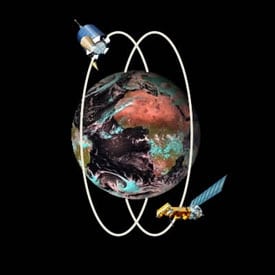
GearUpEpirb
If you’re still lugging around the most common and least expensive type of Emergency Position-Indicating Radio Beacons, which broadcast in the 121.5/243 MHz range, it’s time to replace them. These Class A, B, and S EPIRBs, also called Category B or Mini B, are inexpensive, but you get what you pay for. Their signal has no identification component, and can take up to three or four satellite passes before they can even begin to pinpoint where the distress call is coming from. Frequency congestion in the band used by these devices also causes a high satellite false-alert rate, which means that confirmation of the distress call is required before search and rescue forces can be deployed. Due to these and other drawbacks, it was decided in 2000 that the globe-covering constellation of COSPAS-SARSAT (COSPAS is an acronym for the Russian words Cosmicheskaya Sistyema Poiska Avariynich Sudov which translate to Space System for the Search of Vessels in Distress. SARSAT is an acronym for Search And Rescue Satellite-Aided Tracking) satellites would cease listening for 121/243 MHz signals in 2009.In the United States, the U.S. Coast Guard is getting the public ready for the 2009 deadline by outlawing use of 121.5/243 MHz EPIRBs as of the end of December, 2006. “Beginning January 1, 2007, both 121.5 and 243 MHz Emergency Position Indicating Radio Beacons (EPIRBs) are prohibited from use in both commercial and recreational watercraft,” says a recent USCG directive. “Boaters wishing to have an emergency rescue beacon aboard their vessel must have a digital 406 MHz model.” 406 MHz EPIRBs send out a digital signal, which is detectable by the global network of Russian COSPAS satellites, which are polar orbiting, and by the geostationary GOES weather satellites that make up the American SARSAT system. EPIRBs without a connection to or lacking an integral GPS detected by COSPAS-SARSAT satellites provide rescue authorities the location of the distressed vessel, but location and sometimes alerting may be delayed as much as two hours. [Spend the extra dollars and get a GPS-equipped unit-Eds.].When a 406 MHz beacon signal is received, search and rescue personnel can also retrieve information from a registration database. This includes the beacon owner’s contact information, emergency contact information, and the vessel’s identifying characteristics. Having this information allows rescue personnel to respond appropriately. In the U.S., users are required by law to directly register their beacon in the U.S. 406 MHz Beacon Registration Database at: http://www.beaconregistration.noaa.gov/ or by calling 1-888-212-SAVE. Other users can register their beacon in their country’s national beacon registration database or, if no national database is available, in the International Beacon Registration Database at https://www.406registration.com/. The regulation does not affect 121.5/243 MHz man overboard devices, which are designed to work directly with a base-alerting unit only and not with the satellite system.









